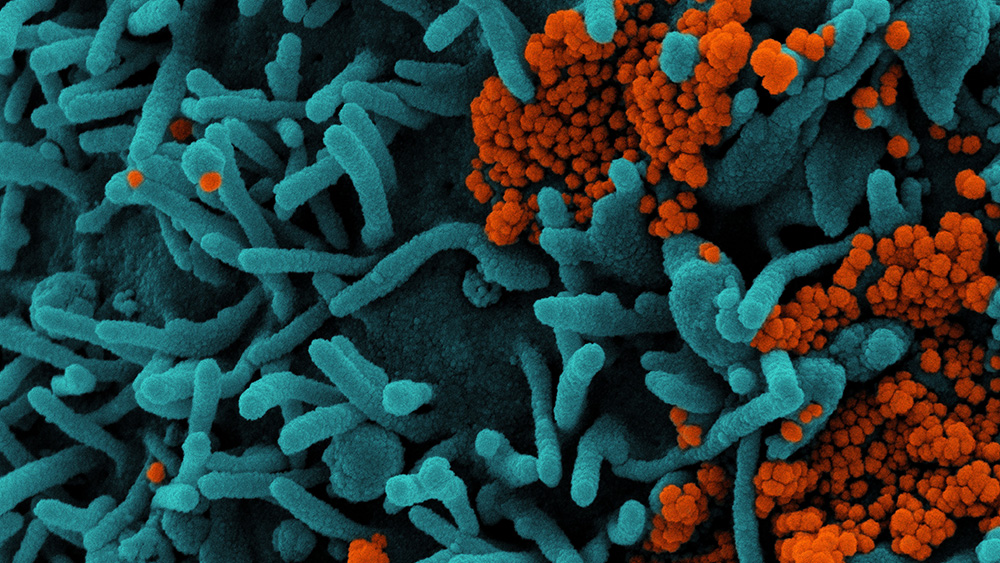
Caption: Magnified photo of a human lung cell (the large teal object) infected with SARS-CoV-2 (orange spheres). The cell and virus particles were from a patient with COVID-19. Credit: NIAID Integrated Research Facility, NIH. Available through a Creative Commons license.

Caption: Magnified photo of a human lung cell (the large teal object) infected with SARS-CoV-2 (orange spheres). The cell and virus particles were from a patient with COVID-19. Credit: NIAID Integrated Research Facility, NIH. Available through a Creative Commons license.
What you need to know
More treatments for COVID-19 are critically needed, especially options that can prevent severe disease and reduce the need for hospitalization. Current treatments such as remdesivir and monoclonal antibodies are available only in hospitals or infusion centers for patients with severe disease.
Researchers at NIH’s Eunice Kennedy Shriver National Institute of Child Health and Human Development (NICHD) have identified a potential new treatment for COVID-19 — TEMPOL — that can be taken orally and may stop the replication of SARS-CoV-2, the virus that causes COVID-19. This treatment would likely prevent severe disease.
How could TEMPOL relieve COVID-19 symptoms?
Just as humans need minerals in their diet, researchers found that SARS-CoV-2 needs clusters of iron and sulfur minerals to replicate in cells. TEMPOL breaks up these clusters and stops the virus from multiplying. This action might prevent severe COVID-19.
Earlier animal and cell culture studies showed that TEMPOL may also reduce COVID-19 symptoms in other ways:
- Calming inflammation. SARS-CoV-2 infection sometimes causes an out-of-control immune response called a cytokine storm, which can damage the lungs and other organs and may cause death. TEMPOL may help prevent cytokine storms.
- Protecting organs from damage. TEMPOL’s antioxidant activity may protect cells by inactivating free radicals — unstable molecules made by out-of-control immune responses — that can damage organs.
- Decreasing clumping of platelets. Platelets are blood cells that help stop bleeding. If they are too sticky and form clumps in blood vessels, as can happen in people with COVID-19, dangerous blood clots can result. TEMPOL may reduce this risk.
Why is this research important?
The U.S. Food and Drug Administration has given the go-ahead for a study of TEMPOL in humans to see whether it can safely prevent hospitalizations. If these studies show that TEMPOL is safe and effective, the oral drug may be authorized for treating COVID-19 at home. An at-home treatment that prevents severe disease could also relieve the burden of COVID-19 on health care systems.
As SARS-CoV-2 spreads, the virus changes, creating new variants. Vaccines prevent COVID-19, but they may be less effective against some variants. New treatment options could help prevent illness and death.
Where can I go to learn more?
NIH Researchers Identify Potential New Antiviral Drug for COVID-19
- NIH's press release announces the findings of research on TEMPOL’s ability to limit SARS-CoV-2 infection.
Study to Evaluate Tempol (MBM-02) to Help Prevent Hospitalizations in COVID-19 Patients
- A clinical trial will test the ability of TEMPOL to reduce hospitalizations for people with COVID-19.
- NIH’s COVID-19 Treatment Guidelines provide clinicians with evidence-based recommendations on the management of COVID-19.
Sources
Francischetti, I. M., Gordon, E., Bizzarro, B., Gera, N., Andrade, B. B., Oliveira, F., Ma, D., Assumpção, T. C., Ribeiro, J. M. C., Pena, M., Qi, C.-F., Diouf, A., Moretz, S. E., Long, C. A., Ackerman, H. C., Pierce, S. K., Sá-Nunes, A., & Waisberg, M. (2014). Tempol, an intracellular antioxidant, inhibits tissue factor expression, attenuates dendritic cell function, and is partially protective in a murine model of cerebral malaria. PLOS ONE, 9(2), Article e87140. https://doi.org/10.1371/journal.pone.0087140
Ghosh, M. C., Zhang, D.-L., Ollivierre, H., Eckhaus, M. A., & Rouault, T. A. (2018). Translational repression of HIF2α expression in mice with Chuvash polycythemia reverses polycythemia. Journal of Clinical Investigation, 128(4), 1317–1325. https://doi.org/10.1172/JCI97684
Maio, N., Lafont, B. A. P., Sil, D., Li, Y., Bollinger, J. M., Jr., Krebs, C., Pierson, T. C., Linehan, W. M., & Rouault, T. A. (2021). Fe-S cofactors in the SARS-CoV-2 RNA-dependent RNA polymerase are potential antiviral targets. Science (New York, N.Y.), 373(6551), 236–241. https://doi.org/10.1126/science.abi5224
Wang, Y., Hai, B., Ai, L., Cao, Y., Li, R., Li, H., & Li, Y. (2018). Tempol relieves lung injury in a rat model of chronic intermittent hypoxia via suppression of inflammation and oxidative stress. Iranian Journal of Basic Medical Sciences, 21(12), 1238–1244. https://doi.org/10.22038/ijbms.2018.31716.7714

News and Stories
Read stories about the efforts underway to prevent, detect, and treat COVID-19 and its effects on our health.
 An official website of the United States government
An official website of the United States government

